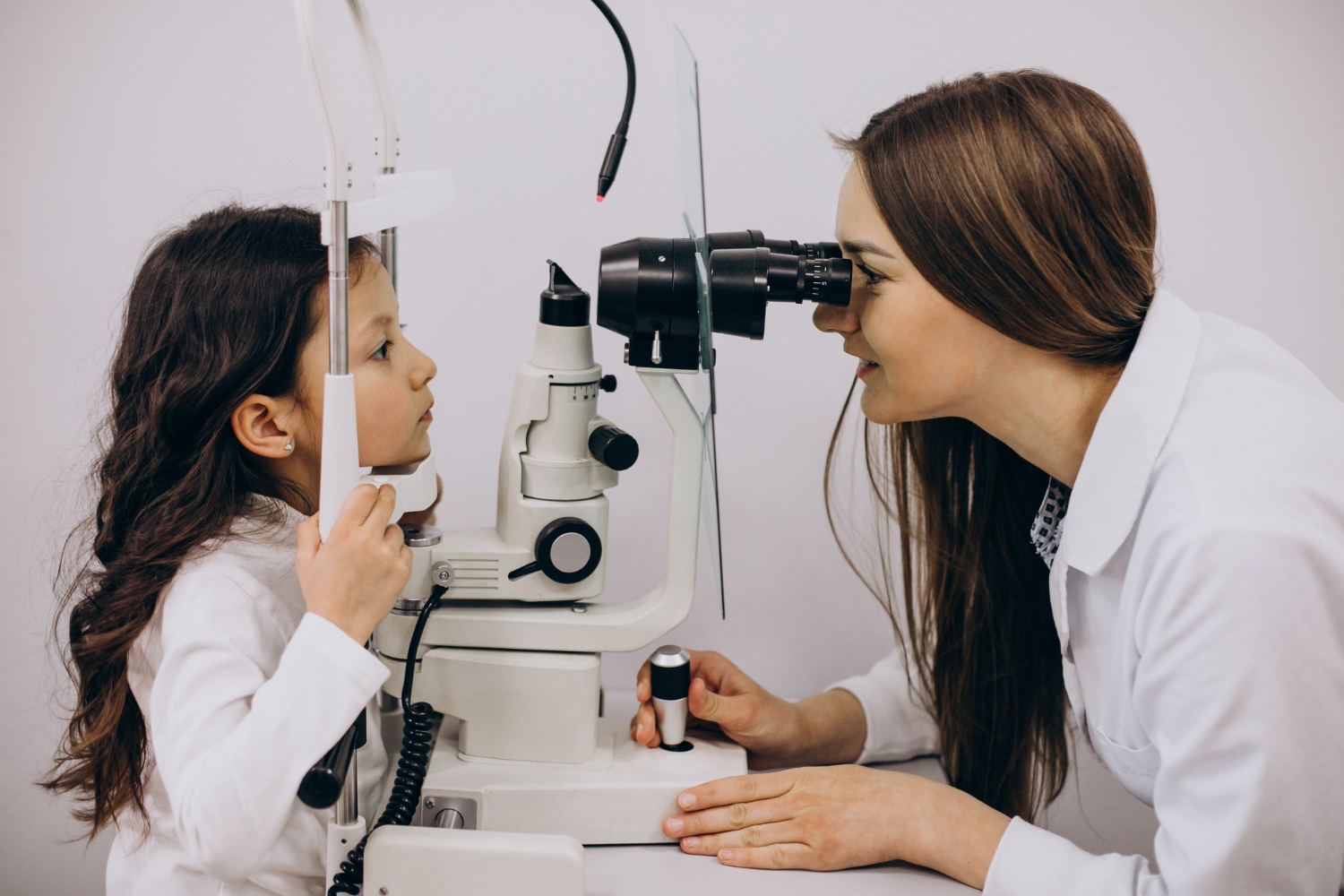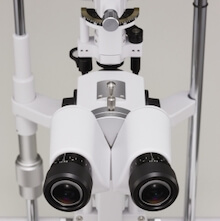Slit Lamp Exam

Table of Contents
What is a Slit Lamp?
A slit lamp is a specialized microscope equipped with a bright light, used during eye examinations. It allows your ophthalmologist to closely examine the structures at the front and interior of the eye. This essential tool plays a crucial role in assessing eye health and detecting potential eye diseases.A slit lamp is called so because it uses a thin, focused beam of light that can be adjusted to form a slit. This slit of light helps eye care professionals to examine the eye structures more clearly and in detail during the examination.
What is the Use of a Slit Lamp?
A slit lamp is a specialized microscope equipped with a bright light, used during eye examinations. It allows your ophthalmologist to closely examine the structures at the front of the eye as well as the internal components, helping to detect various eye conditions.
What is the Principle of a Slit Lamp?
The slit lamp is a stereoscopic biomicroscope that projects a focused beam of light with adjustable height, width, and angle. This advanced instrument enables three-dimensional visualization and precise measurement of the fine anatomy of the adnexa and the anterior segment of the eye.
What is a Slit Lamp Exam?
A slit lamp exam is a test that allows an eye care specialist to thoroughly examine all parts of your eyes, including their internal structures. It is a standard component of a routine eye examination.
The slit lamp is a specialized microscope with a bright light that your eye care specialist uses to inspect various parts of your eyes. By adjusting the light, they can view and assess the layers of your eyes in detail. This exam helps evaluate the overall health of your eyes and identify any conditions or symptoms you may be experiencing.
Your eye care specialist will likely dilate your pupils for the slit lamp exam. Since dilated pupils can affect your ability to drive, make sure to arrange transportation or have someone pick you up after your appointment.
What Does This Exam Help Diagnose?
A slit lamp examination can help detect various eye conditions, including:
Macular degeneration – A progressive disease affecting the part of the eye responsible for central vision.
Detached retina – A condition where the retina, a crucial tissue layer at the back of the eye, separates from its underlying support.
Cataracts – Clouding of the eye’s lens, leading to blurred or impaired vision.
Corneal injury – Damage to the cornea, the outermost layer of the eye.
Retinal vessel blockages – Obstructions in the blood vessels of the eye, which may cause sudden or gradual vision loss.
Speak with your doctor about what they are examining and any potential eye conditions you may be at risk for.
What Happens During a Slit Lamp Exam?
When you sit in the examination chair, the doctor will position an instrument in front of you to rest your chin and forehead, helping to keep your head steady during the exam. Your eye doctor may apply eye drops containing a yellow dye called fluorescein to highlight any abnormalities on the surface of your cornea. These drops temporarily stain your tears for better visibility. Additional drops might be used to dilate your pupils, making them larger for a more thorough examination.
Using a low-powered microscope and a slit lamp, which emits a high-intensity light, the doctor will closely examine your eyes. The slit lamp features various filters to provide different views of the eye’s structures. Some clinics may also have technology that captures digital images to monitor changes in your eyes over time.
When Would I Need a Slit Lamp Exam?
You’ll likely need a slit lamp exam every few years to help your eye care specialist monitor any changes in your eyes and identify any symptoms you may be experiencing. This exam is used to screen for various eye conditions, including:
- Cataracts
- Glaucoma
- Dry eye
- Corneal abrasions (scratched corneas)
- Corneal diseases
- Macular degeneration
- Retinitis pigmentosa
Your eye care specialist will advise you on how often you should have a slit lamp exam and explain the specific conditions or changes they are monitoring.
What Does a Slit Lamp Exam Show?
Doctors use the slit lamp as part of a comprehensive eye exam to closely examine the structures within the eyes, including:
- Conjunctiva: A thin, transparent membrane that covers the white part of the eye and the inner surface of the eyelids.
- Cornea: The clear, dome-shaped covering over the iris and pupil, which protects the eye and helps direct light through the pupil to the retina.
- Eyelids: Protect the eye from debris and injury, while blinking lubricates the eye and prevents dryness.
- Iris: The colored part of the eye that controls how much light enters by adjusting the size of the pupil.
- Pupil: The black, central opening in the eye that lets light pass through to the retina.
- Lens: Positioned behind the iris, it focuses light onto the retina for clear vision.
- Sclera: The white, tough outer layer of the eye that provides structure and protection.
- Retina: The light-sensitive tissue at the back of the eye, which contains cells that detect light and connect to nerves forming the optic nerve.
The slit lamp allows for detailed observation of these structures, helping to identify potential issues or abnormalities. The slit lamp exam provides a detailed view of the eye structures, enabling the eye care provider to detect any abnormalities or issues that may be present.
What Should I Expect After a Slit Lamp Exam?
There’s nothing you need to do after a slit lamp exam. If your pupils were dilated, you shouldn’t drive until they return to their usual size.
Your eyes will probably be more sensitive to light while they’re dilated. It might help to wear sunglasses for a few hours after your exam. You can return to all your normal activities as soon as your pupils aren’t dilated.
Slit Lamp Product for Eye Examination
Mediworks Digital Slit Lamp
The Mediworks Digital Slit Lamp S390L merges traditional slit lamp examination with digital imaging technology, offering unparalleled clarity and detail in eye examinations.
It features high-resolution optics and a digital camera for capturing and analyzing eye conditions. Designed for both anterior and posterior segment analysis, its ergonomic design ensures user and patient comfort. Ideal for advanced diagnostic needs, it’s a vital tool for enhancing patient care and education in ophthalmic practices.
Rexxam Digital Photo Slit Lamp

The Rexxam RS 5000 Digital Photo Slit Lamp integrates advanced digital imaging with traditional slit lamp examination, enabling precise, high-resolution documentation of ocular conditions.
It features user-friendly controls, versatile illumination, and magnification options, facilitating detailed anterior and posterior segment analysis. Ideal for diagnostic and monitoring purposes, its ergonomic design enhances comfort and efficiency in clinical settings, making it a top choice for ophthalmologists seeking to elevate their practice with cutting-edge technology.
Lab Medica Systems specializes in importing and supplying slit lamps at latest price in India, essential for eye examinations in healthcare. They offer a variety of models to cater to diverse medical needs, ensuring high-quality and compliance with regulatory standards. Their services extend beyond sales to include installation, training, and technical support, demonstrating a commitment to healthcare professionals’ needs. By staying abreast of medical advancements, they provide technologically advanced and safe medical equipment.

